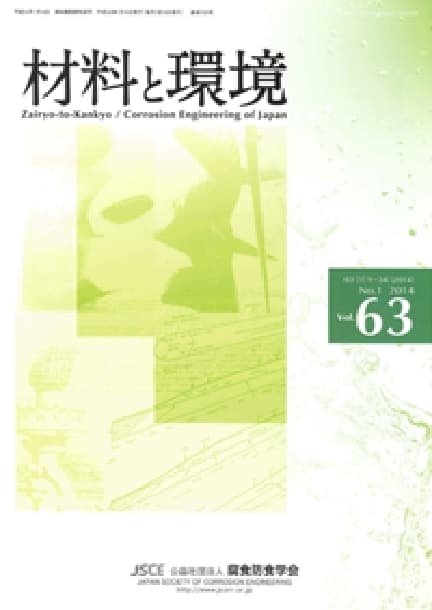材料と環境 Vol. 71 (2022), No. 7
Backnumber
-
Vol. 74 (2025)
-
Vol. 73 (2024)
-
Vol. 72 (2023)
-
Vol. 71 (2022)
-
Vol. 70 (2021)
-
Vol. 69 (2020)
-
Vol. 68 (2019)
-
Vol. 67 (2018)
-
Vol. 66 (2017)
-
Vol. 65 (2016)
-
Vol. 64 (2015)
-
Vol. 63 (2014)
-
Vol. 62 (2013)
-
Vol. 61 (2012)
-
Vol. 60 (2011)
-
Vol. 59 (2010)
-
Vol. 58 (2009)
-
Vol. 57 (2008)
-
Vol. 56 (2007)
-
Vol. 55 (2006)
-
Vol. 54 (2005)
-
Vol. 53 (2004)
-
Vol. 52 (2003)
-
Vol. 51 (2002)
-
Vol. 50 (2001)
-
Vol. 49 (2000)
-
Vol. 48 (1999)
-
Vol. 47 (1998)
-
Vol. 46 (1997)
-
Vol. 45 (1996)
-
Vol. 44 (1995)
-
Vol. 43 (1994)
-
Vol. 42 (1993)
-
Vol. 41 (1992)
-
Vol. 40 (1991)
キーワードランキング
15 Dec. (Last 30 Days)
材料と環境 Vol. 71 (2022), No. 7
遅れ破壊抑制のためのショットピーニングおよびセラミック溶射
竹本 幹男, 中村 元昭, 植野 修一
pp. 192-207
DOI:
10.3323/jcorr.71.192抄録
Authors studied how we could control the delayed fracture of three point bent spring steel using shot peening or thermal spraying of oxide ceramic. We first introduce properties of the shot peened spring steel and then explore the effect of hydrogen-supplement method (hydrogen charge) on the susceptibility of delayed fracture. Next we discuss threshold strains by Conventional Immersion Test (called as CIT method) of bent specimens. Further, we propose an alternate evaluation method using acoustic emission (AE). Here we determine the threshold strain by measuring AEs during Step-wise Strain Increasing (SSI-AE method) of hydrogen pre-charged specimens. We introduce two cases where the shot peening can or can’t control the delayed fracture, depending on both the hydrogen charge method and the strength level of the steel. We also discuss problems and advantages of the CIT and SSI-AE methods. We studied a method for controlling the diffusion rate of hydrogen into the steel using thermal spraying of conductive titania, and demonstrated how this method was effective for improving the threshold strain for the system where the shot peening could not be an effective countermeasure against the delayed fracture.
他の人はこちらも検索
MATERIALS TRANSACTIONS Vol.62(2021), No.1
日本エネルギー学会誌 Vol.101(2022), No.8
日本エネルギー学会誌 Vol.99(2020), No.12
Effects of Metal Cations on Corrosion Morphology of Carbon Steel in Model Fresh Water
Li Li, Masatoshi Sakairi
pp. 208-212
DOI:
10.3323/jcorr.71.208抄録
The effects of metal cations on corrosion morphology of carbon steel immersed in model fresh water were investigated by surface observation and analysis. Different surface and cross-sectional morphologies were observed by scanning electron microscope. The X-ray photoelectron spectroscopy and cross-sectional Auge electron spectroscopy point analysis results suggested that the corrosion products formed in Zn2+ containing solution contained Zn compounds.
AE法を用いた腐食した鋼製ボルト締結部の破断強度評価
松尾 卓摩, 徳原 功也
pp. 213-217
DOI:
10.3323/jcorr.71.213抄録
Acoustic emission (AE) method was used to evaluate the fracture strength of corroded steel bolt joints. AE monitoring was carried out on steel bolted joints subjected to corrosion accelerated test using NaCl solution with different duration. After the corrosion test, the tensile strength of bolted joints was evaluated. A correlation was found between the fracture strength of corroded bolted joints and cumulative AE events. Next, the relationship between the parameters of the AE waveforms and the corrosion conditions was evaluated. As a result, waveforms with a strong amplitude of the guided wave L(0, 1) mode were detected in the bolted joints with severe corrosion, and the peak frequency of AE signals tended to decrease. In addition, many AE signals with high maximum amplitude were detected in the bolted joints where corrosion had progressed. These results indicated the possibility of estimating the fracture strength of bolts from parameters such as amplitude and frequency.
大気腐食環境下における亜鉛めっき鋼材の水素侵入挙動におよぼす腐食過程の影響
秦 謙太郎, 松田 武士, 大塚 真司
pp. 218-224
DOI:
10.3323/jcorr.71.218抄録
The effect of corrosion status of zinc coating on the hydrogen absorption behavior was investigated. Dry-wet corrosion test was conducted after applying NaCl solution to the zinc coated steel sheets. The permeating hydrogen during the corrosion test was measured by electrochemical technique. It was found that the hydrogen permeation was not observed at early stage of corrosion while significant hydrogen permeation was observed at middle stage of corrosion. Then, the hydrogen permeation decreased gradually at later stage of corrosion. In order to clarify the mechanism of this behavior, surface morphologies of corroded specimens were analyzed by Electron Probe Micro Analyzer. It was found that the hydrogen permeation was observed when the steel substrate was partially appeared, indicating that galvanic corrosion is related to the hydrogen permeation.
論文アクセスランキング
15 Dec. (Last 30 Days)
-
大気腐食環境下における1700 MPa級調質ボルトの遅れ破壊機構
鉄と鋼 早期公開
-
Perspectives on the Promising Pathways to Zero Carbon Emissions in the Steel Industry toward 2050
ISIJ International Vol.65(2025), No.2
-
-
Factors Influencing the Bonding Phase Structure of Iron Ore Sinters
ISIJ International Vol.43(2003), No.9
-
-
-
Progress of Strip Casting Technology for Steel; Historical Developments
ISIJ International Vol.52(2012), No.12
-
Research Progress on Optimal Blending of Iron Ore Powders for Sintering
ISIJ International Vol.65(2025), No.12
-
-
Microstructures and Reduction Properties of High CaO Concentration Sintered Ore
ISIJ International 早期公開
この機能はログイン後に利用できます。
下のボタンをクリックしてください。










